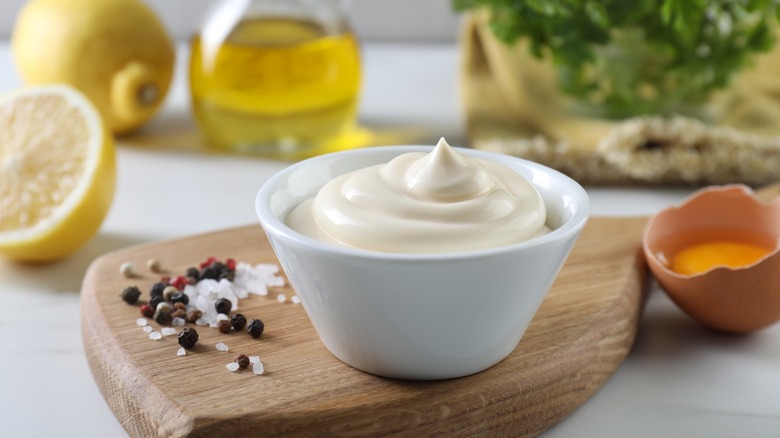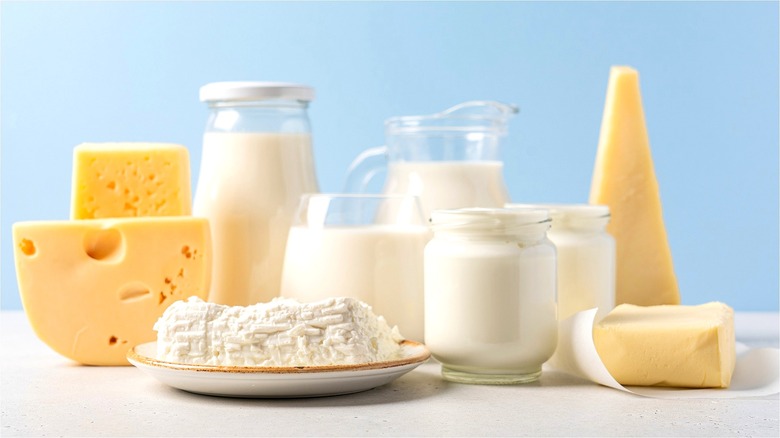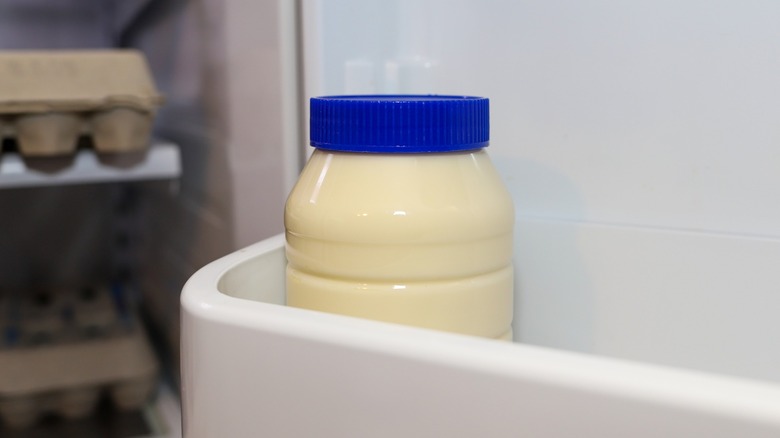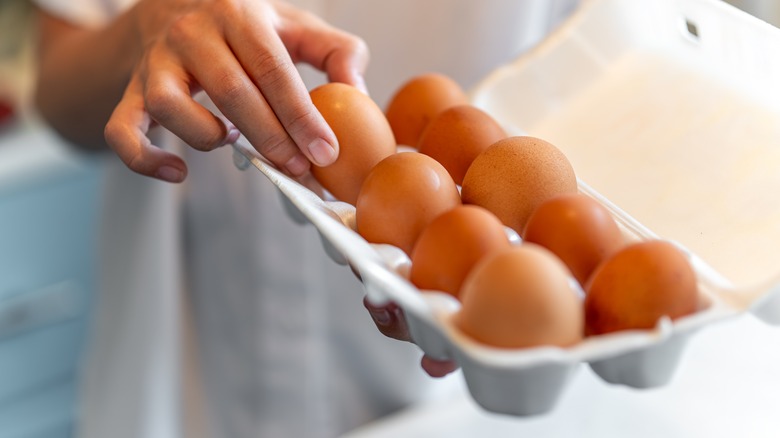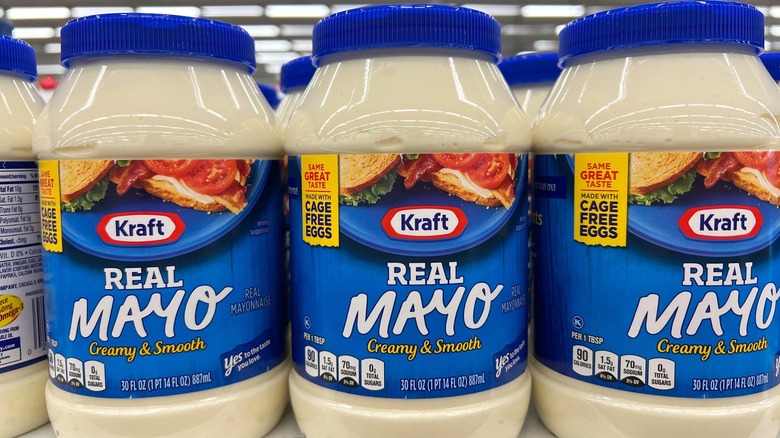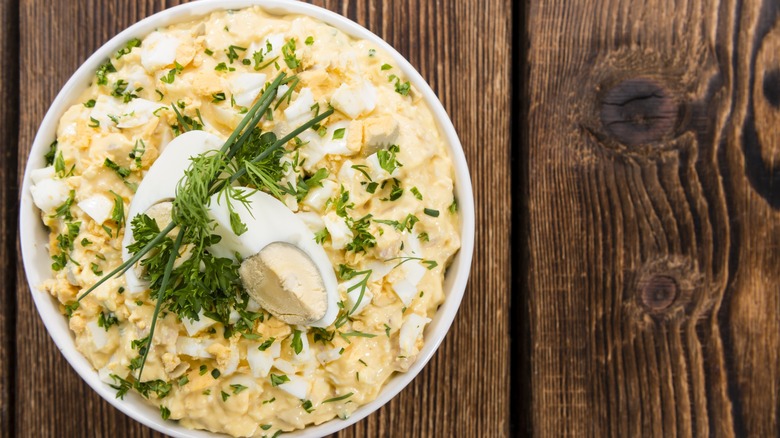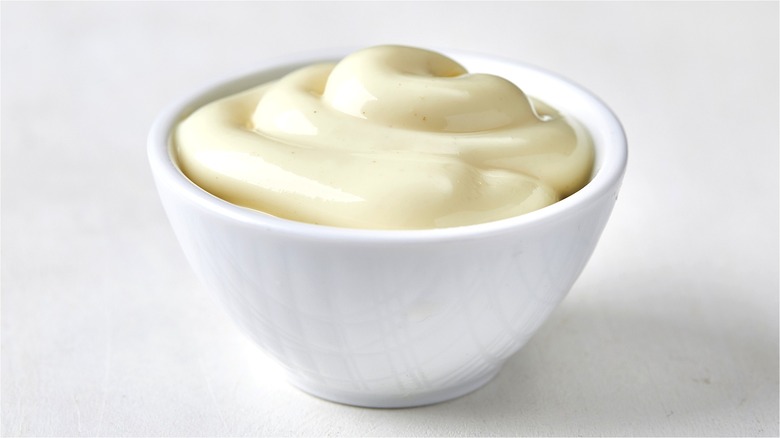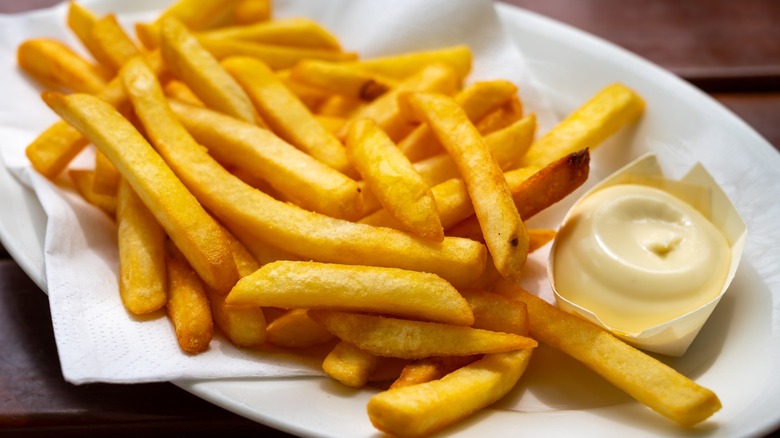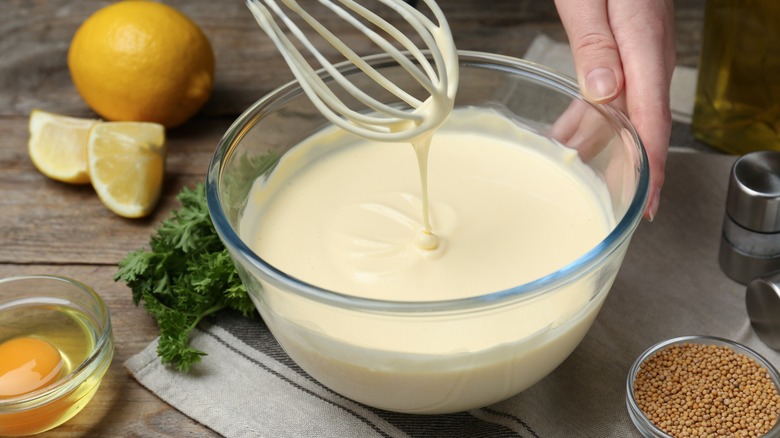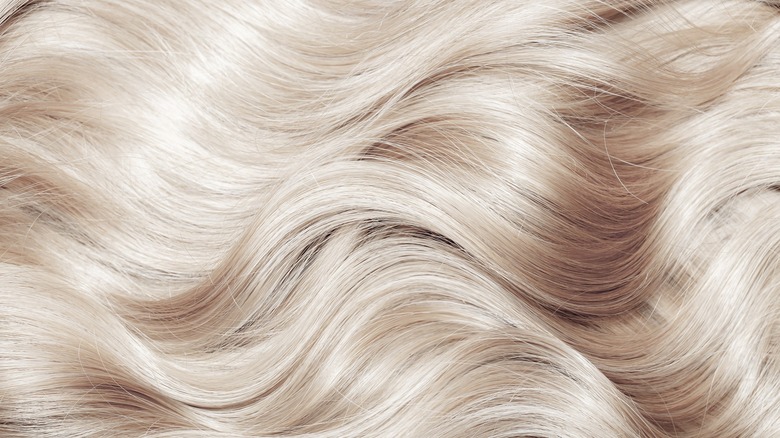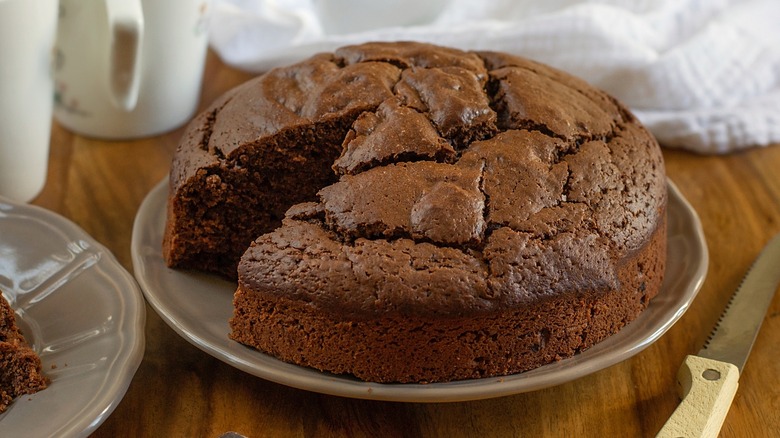12 Common Myths About Mayonnaise Debunked
We're willing to bet that there's a jar of mayonnaise in your fridge right now. That's because, for the vast majority of Americans, mayonnaise is a part of everyday life. In 2020, just shy of 277 million people consumed mayo or a salad dressing that contained mayo (per Statista). Amazingly, though, for such a common food, mayonnaise has an extraordinary amount of myths attached to it that a lot of us still believe. These myths often lie in the realm of food safety. For example, Mayonnaise is often linked to cases of food poisoning — either when used in salads or simply when kept at room temperature.
Mayonnaise is also one of those foods that's often believed to be way more unhealthy than it actually is, and several myths have arisen about its cholesterol levels and lack of nutrition. Other myths around mayo are way wackier (like using it as part of your hair care routine). Beyond that, no one can seem to agree on where the food comes from, or what type of food it is — leading to a host of false truths about mayonnaise's origin and composition. There's a lot of fiction to put right, but luckily, we're here to give you the lowdown on this classic condiment.
1. Myth: Mayonnaise is a dairy product
It's white, it's smooth, and it has a creamy, gentle taste. Essentially, everything about mayo points to it being a dairy product. The truth, though, is that it's not dairy at all. Mayonnaise can't be classified as a dairy product because it doesn't contain anything that comes from the milk of a mammal. Instead, it's made of a combination of eggs and oil that are blended together until they emulsify, along with some kind of acid, like vinegar or lemon juice.
But what about eggs? Well, contrary to popular belief, eggs aren't dairy. This is because they come from birds and not from mammals. They're often lumped into the same category due to their similar flavor notes, but the eggs and dairy are actually pretty distinct. The lack of dairy in mayonnaise means that folks with lactose intolerance or a dairy allergy should feel safe in the knowledge that they can eat the condiment to their heart's content. It is worth bearing in mind, however, that while the majority of mayonnaises are made without any dairy, some egg-free varieties may be made with condensed milk. Therefore, it's always important to check ingredient lists, or ask the person who made the mayo what went into it.
2. Myth: Store-bought mayo always needs to be refrigerated
Mayo is one of those foods that really feels like it can't be kept at room temperature. Given that eggs are its primary ingredient, there's something that feels counterintuitive about leaving it in the pantry (instead of stashing it in the fridge). Interestingly, though, unopened store-bought mayonnaise is perfectly fine when kept unrefrigerated. It's the high levels of both fat and acid in mayonnaise that keep it from perishing at room temperature, with its approximate pH value of around 4.2 putting it in the same range as pickled onions or tomatoes canned in juice.
There's a big caveat to this, however. While unopened store-bought mayo is fine when kept at room temperature, once it's opened, you really should put it in the fridge. Store-bought mayos are sealed with sanitation and bacterial invasion in mind, but once the lid's off and air can get to the food in the jar, things can start to go bad pretty quickly. Some brands may well be okay to keep at room temp, though: As with anything, make sure you're checking the label carefully, and following the instructions provided to the letter. As well as this, you should also remember that homemade mayo should always be refrigerated.
3. Myth: Mayonnaise is high in cholesterol
Cholesterol is a word that usually gets people's attention, and not for good reasons. Having higher blood cholesterol levels, and particularly "bad" LDL cholesterol, is frequently associated with a higher risk of heart disease (per Healthline). This has led to people watching their cholesterol intake from food way more closely. As mayonnaise is made from eggs — which are well-known for being high in dietary cholesterol –it's led folks to assume that the condiment isn't great for your heart.
However, this is largely untrue. While the cholesterol levels in mayonnaise brands differ, one of the most well-known store-bought options, Hellmann's mayonnaise, has as little as 10 milligrams per serving. This equates to roughly 3% of your daily value for dietary cholesterol, with the U.S. Food and Drug Administration recommending that you consume no more than 300 milligrams per day. Kraft Real Mayo, meanwhile, has even less, providing under 5 milligrams per portion. Importantly, though, homemade mayonnaise — which may rely more heavily on egg yolks to provide its bulk — may have more than this.
Crucially, there is a difference between blood cholesterol and dietary cholesterol. The body is fairly adaptive when people consume more dietary cholesterol than is recommended, and for most people, eating too much doesn't seem to negatively impact their blood cholesterol levels. Having said this, some folks do see a correlation between dietary cholesterol intake and blood cholesterol, so you should always try to keep your intake moderate wherever possible.
4. Myth: Store-bought and homemade mayo have the same shelf life
Mayo's mayo, right? Well, not quite. Store-bought and homemade mayo have some distinct differences, with some finding the taste of the homemade version more complex. Because homemade mayonnaise is made with raw eggs, too, the timespan in which you have to eat it is smaller, and the idea that both store-bought and homemade mayo can be kept for the same amount of time is a total lie. In fact, homemade mayo should be eaten within two weeks and may start to go bad earlier than that, depending on how fresh your eggs are and the conditions you're keeping it in.
There are ways that you can extend the shelf-life of your homemade mayo, though. One of them is by using pasteurized eggs. As pasteurizing eggs kills off bacteria that could contaminate them, this will buy you a few more weeks, and you can likely keep your mayo for up to a month before you have to throw it out. If you want mayonnaise to last longer than that, you should go for the store-bought variety: The acidity levels and added preservatives of this kind keep it fresh for a good few months when kept in the fridge.
5. Myth: Using mayo in salads can cause food poisoning
A lot of people are intimately familiar with the experience of eyeing up an egg salad at a hot summer barbecue, spooning it generously onto their plate, and then spending the next two days hunched over the toilet. These unfortunate turns of events, which are all too frequent, have led to the assumption that the combination of mayonnaise and salad foods is somehow bad for you, and that it's the mayo itself that causes food poisoning from salads.
This is far from true. It's actually the things that mayo is combined with, like meat or cooked eggs, which end up generating the bacteria that make you ill in these situations. Because of mayonnaise's acidic composition, it tends to be better at inhibiting bacteria growing in it. Interestingly, research published in the Journal of Food Protection found that adding mayonnaise to food can actually help to slow down the bacteria that grows on it, although it doesn't stop it completely. Having said this, we'd always recommend just keeping your mayo-based salads in the fridge for as long as possible, and never at room temperature for more than two hours, to avoid any risk of food poisoning.
6. Myth: Mayo is really unhealthy
We can understand why people think mayonnaise isn't good for you. It's creamy, it's made primarily with fats, and it's not exactly bursting with the vibrant green appearance that we often associate with health and wholesomeness. However, it's a mistake to assume that mayonnaise is totally devoid of nutrition, or that it's especially unhealthy. Mayonnaise does have some positive nutritional factors going for it, and it provides some good quantities of vitamins E and K. Thanks to the eggs that go into it, it can also be a good source of omega-3 fatty acids, which are renowned for their ability to bolster heart and brain health.
However, it all depends on how your mayonnaise is made. Mayonnaise is largely composed of oil, and if the manufacturer of your chosen brand uses a cheaper, less heart-healthy oil (like soy-based oils), this can put it back in unhealthy territory. There's also no getting around the fact that mayonnaise is high in fat, and consuming too much of it may unbalance your nutritional intake. Like anything, you need to eat it in moderation — but with a well-chosen brand that's high in eggs and low in added ingredients (or with a homemade, relatively unprocessed version), it can still be part of a healthy diet.
7. Myth: Mayonnaise was invented in France
There are lots of reasons why you might think mayonnaise is French. First of all, there's its name, which some folks think is derived from "moyeunaise," with "moyeu" meaning "egg yolk" in Old French. Then, there's its widespread use in French cuisine — particularly as a base for various sauces — and its proximity to aioli.
The truth about where mayonnaise actually comes from, though, is a bit more complicated than that — and it's still unclear as to whether it was actually invented in France. One of the commonly-told origins stories of mayonnaise (which interestingly, used to be considered a luxury food) is that following a successful assault on the Port of Mahon in Menorca by the French in 1756, the chef of the French admiral invented mayonnaise to celebrate. It was then named after the port that the French attacked, and was thereby called "mahonnaise." Others, however, have argued that the recipe for mayonnaise was stolen from the Menorcan residents and their own native sauce, known as Salsa Mahonesa.
There are also claims that the condiment was actually invented in Bayonne, a city in Southwest France, with "mayonnaise" being derived from "bayonnaise." Until there's a definitive answer to its origin (and there may never be), though, it'd be a mistake to say that it's indisputably a French invention.
8. Myth: People shouldn't make mayo when they're menstruating
Not all the myths that surround mayonnaise are about its storage or ability to cause food poisoning. Some are more culturally specific, and perhaps slightly less common in the Western world — but no less worth mentioning. In Madagascar, a belief has persisted in some sections of society that people with uteruses shouldn't try to make mayonnaise when they're menstruating. The rumor goes that, if they try to do so, the mayonnaise will curdle and therefore be inedible.
We can understand how this link may have come about, with mayonnaise being made from eggs, and menstruation and ovulation being directly involved with one another. However, it remains a cultural myth, largely passed down from generation to generation. There is no concrete evidence that making mayonnaise during menstruation causes it to curdle, and the myth has been refuted by individuals living in Madagascar who have made mayonnaise during their periods and have found that it doesn't curdle at all. Initiatives have been started in Madagascar to better educate people, specifically young men, on myths like this, to better prepare future generations for conversations about menstruation.
9. Myth: Aioli is just mayonnaise with garlic mixed into it
Garlic mayonnaise is a thing of beauty: Creamy, tangy, savory, and bright, it's the perfect accompaniment to fries or nuggets, or simply smeared onto a sandwich. However, this condiment is frequently assumed to be something it's not. Garlic mayonnaise is often referred to as aioli, and vice versa, and people often therefore assume that aioli is just mayonnaise with garlic (fresh or powdered) mixed into it.
The truth isn't quite as simple as that. Aioli can be several different things, and in its simplest form is a blended combo of olive oil and fresh garlic, processed together to make a creamy, fluffy sauce. The mixture of the two creates an emulsion, which then gives the aioli body. This version, of course, contains no egg whatsoever, and so is pretty far removed from mayonnaise, despite looking pretty similar. There are, however, aioli recipes out there that incorporate eggs — but these recipes don't just involve mixing garlic into mayo, but combining the ingredients from the first moment to build the condiment from the ground up. Easy aioli recipes can also be as simple as mixing garlic and other seasonings into mayo — and doing so gives it a great flavor — but don't forget the nuances of this multifaceted sauce.
10. Myth: Mayonnaise is great for your hair
If your mouth has ever dropped open from someone telling you that mayonnaise is good for your hair, you're not alone — this is a myth that we'd be happy to forget about. Luckily for everyone who doesn't want to spoon Hellmann's onto their head (most of us), it's largely untrue. It's not entirely clear where the rumors about "mayonnaise hair masks" being good for your flowing locks came from, but there's a curiously persistent belief that smearing it onto your scalp will help improve your hair's moisture levels, reduce frizz, cause it to grow better, and make your hair more robust. The reasoning behind it goes that mayo's oily, egg-based composition helps replace natural oils in your hair and make it more robust.
However, the fact remains that there simply isn't enough scientific evidence to back up these statements. Mayonnaise may well help with certain hair types, with curly and wavy hair potentially benefiting from the oils in the food, but generally, you can get the same or better effect with other products. If you're using commercial mayo, too, you may also be smearing preservatives and additives into your hair you'd rather do without. Plus, avoiding the use of mayo in your hair means you don't have to smell like a sandwich all day. That's fine by us.
11. Myth: Hellmann's invented mayonnaise cake
Hellmann's is a big name in the mayo world, and it's largely thought to be responsible for one of mayonnaise's most interesting uses. The concept of mayonnaise cake may sound strange, but once you get over the thought of glopping the condiment into chocolate cake batter it makes sense. With its neutral taste, its composition of oil and eggs, and its high moisture content, mayo can add richness, density, and tenderness to cake without taking its flavor in a strange direction.
Mayonnaise cake is commonly attributed to Hellmann's due to it being popularized by Mrs. Frank Price, the wife of a Hellmann's salesman who proposed that the company might want to use her mayo method to boost sales of the product. This fateful moment occurred in 1937 — a full 10 years after the first recipe for mayonnaise cake appeared in print. In 1927, writer Martha Lee put her recipe down in the Oakland Tribune, for a cake containing dates, walnuts, spices, cocoa powder, and mayo. Lee's recipe, however, called for folks to make their own mayonnaise, whereas Price's used the ready-made stuff. However you look at it, though, it's clear that mayo was showing up in batters long before Hellmann's caught wind of this trick.
12. Myth: Outside of the kitchen, there are limited uses for mayonnaise
There are a lot of uses for mayonnaise you should know, but nearly all of the ones you can probably think of are in the kitchen. However, the idea that you can only use it in culinary applications is an untruth that we're keen to dispel. Mayonnaise's simple composition and relatively neutral smell lends itself to a surprising range of uses beyond the kitchen, where it can create shine and offer an impressive ability to clean.
The oily, eggy consistency of mayo means that it can give household items a brilliant sheen. It's particularly effective on house plants — all you have to do is dab a little mayo across the top of the leaves and buff it off, leaving them glossy and sparkling. You can do the same thing with piano keys, with its shiny oiliness leaving you wanting to play your favorite concerto immediately.
Mayo can also be used to get rid of pesky water rings on wooden furniture. As with your plants and piano, just dab some mayo onto any rings, leave it for a little while, and then buff it off with a clean cloth. Mayo may also help to lift crayon marks from your walls, although bear in mind that it may not work on all types of paint or wallpaper.
